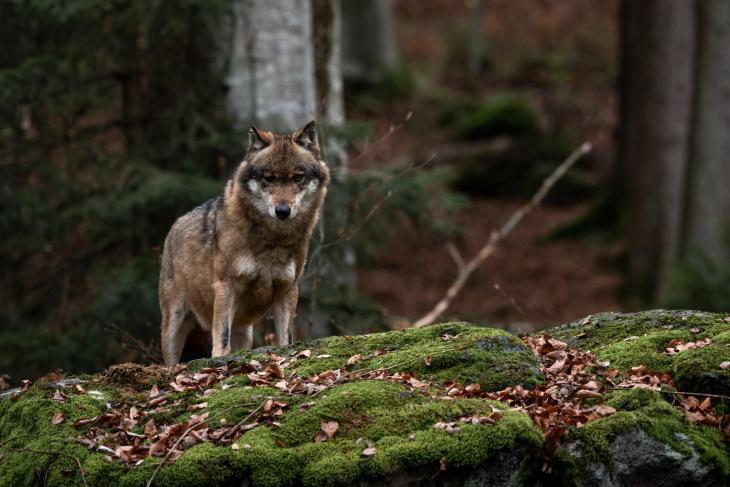Research Examines Ways to Improve the Ability of Humans and Carnivores to Co-Exist
Adaptation strategies for carnivores and humans co-existence is crucial to carnivore conservation efforts around the world.
For release: July 5, 2016
Contact: communications@sesync.org; (410) 991-4810
Kathleen Tuck; kathleentuck@boisestate.edu; (208) 426-3275
A paper written by Neil Carter—a past postdoctoral fellow at the National Socio-Environmental Synthesis Center (SESYNC) at the University of Maryland and current assistant professor in the Human-Environment Systems Research Center in the College of Innovation and Design at Boise State University—and John Linnell, a senior research scientist at the Norwegian Institute for Nature Research, was published in the journal Trends in Ecology and Evolution. Carter began his research on this project while a postdoctoral fellow at SESYNC.
Titled “Co-adaptation is key to coexisting with large carnivores,” the paper looks at ways to improve the ability of humans and carnivores to co-exist, which is crucial to carnivore conservation efforts around the world.
SESYNC’s approach to socio-environmental research is unique in that it supports new collaborations among scientists and postdocs to improve understanding of complex problems and how this research can inform public policies. “Dr. Carter’s paper on the coexistence of people and large carnivores and how they adapt to living with each other is a reminder that interdisciplinary synthesis can lead to actionable science,” said Margaret Palmer, director of SESYNC and distinguished university professor at the University of Maryland. “As a postdoc at SESYNC, Dr. Carter developed the idea for this research collaboration at a meeting in Norway with his co-author. That meeting ultimately resulted in this publication by framing research questions so the results will be useful to decision makers.” SESYNC offers travel and logistical support, computational resources, and facilitation services to help postdocs and research teams overcome the myriad challenges involved in addressing complex questions at the intersection of humans and the environment.
In the paper, the researchers note that large carnivores, such as tigers, wolves, and bears, need larger ranges than many protected areas afford. This means that carnivores often come in contact with human populations that are sometimes less than welcoming.
Carter and Linnell wondered what actions could help mitigate the negative impacts of these contacts, allowing both humans and carnivores to more peacefully coexist. They suggest that mutual adaptations are key to success, requiring flexibility in the rules that govern contact.
A major factor for success has to do with “tolerable levels of risk.” The risks from carnivores range from damage to livestock or property to competition with hunters or even human deaths. Rather than trying to eliminate all risk, which can mean eliminating a species, the authors explore ways to keep risks below tolerable levels.
That involves understanding what factors influence tolerance. While some communities may not tolerate any risks from carnivores, others may tolerate high risks because they attribute carnivores with ecological and cultural benefits that exceed those risks. For instance, despite the livestock depredation risk posed by snow leopards, Tibetan Buddhist monasteries protect the habitat of the rare big cat because of their religious importance.
The comeback of some large carnivore species in the Unites States and Europe, thanks in large part to more protective public policies, is a reflection of changing attitudes toward carnivores in these areas.
But more remains to be done. In many communities, the priorities of various stakeholder groups are still sometimes at odds, and there is a reduced trust in authorities. Interventions such as new policies addressing zoning and the restoration of prey species must take into account human and ethical concerns, the authors say, such as the adoption of novel decision-making strategies that give voice to varying viewpoints.
Carnivores’ amazing ability to adapt to new conditions – such as shifting their diet to smaller wild prey species instead of livestock — show their capacity to thrive in human-dominated environments. That adaptability, however, increases the likelihood of negative encounters between people and carnivores.
But humans can adapt as well through a variety of means, including the use of dogs to guard livestock, lighting livestock corrals, using livestock enclosures, and changing behaviors to avoid carnivore encounters, among others. However, convincing people to use these tools to adapt to the presence of carnivores can be a challenge if they lack the resources, such as materials for corrals, or knowledge to adopt these strategies.
Carter and Linnell believe that challenge is surmountable through the help of community leaders, conservation organizations, and state or federal agencies. Insights from studies on coexistence “can help reconcile debates about carnivore conservation in shared landscapes and advance broader discourses in conservation,” they wrote, “such as those related to rewilding, novel ecosystems, and land-sharing vs. land-sparing.”
About SESYNC
The National Socio-Environmental Synthesis Center, funded through an award to the University of Maryland from the National Science Foundation, is a research center dedicated to accelerating scientific discovery at the interface of human and ecological systems. Visit us at www.sesync.org and follow us on Twitter at @SESYNC.
About Boise State University
A public metropolitan research university with more than 22,000 students, Boise State is proud to be powered by creativity and innovation. Located in Idaho’s capital city, the university has a growing research agenda and plays a crucial role in the region’s knowledge economy and famed quality of life. In the past 10 years, the university has quadrupled the number of doctoral degrees, doubled its masters degrees and now offers 13 online degree programs. Learn more at www.BoiseState.edu.
###
